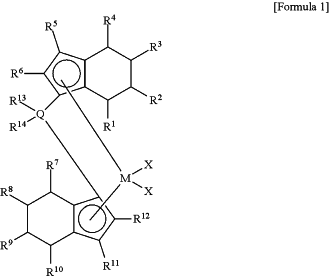| CPC C08F 4/65916 (2013.01) [C08F 4/65912 (2013.01); C08F 4/65927 (2013.01); C08F 2410/02 (2013.01)] | 12 Claims |
|
1. A process for preparing a supported metallocene catalyst for olefin polymerization, which comprises (1a) adding a cocatalyst compound to a transition metal compound; or (1b) adding a cocatalyst compound to a carrier; (2) forming a supported catalyst by supporting the transition metal compound obtained in step (1a) on a carrier, or by supporting a transition metal compound to the carrier obtained in step (1b); and (3) primarily treating the supported catalyst with a solution or suspension of an antistatic agent; and then washing the supported catalyst with a solvent and drying it, and (4) secondarily treating the supported catalyst with dry powder of an antistatic agent,
wherein the transition metal compound is represented by Formula 1:
 in Formula 1, M is a transition metal of Group 4 of the Periodic Table of the Elements;
Q is any one of carbon, silicon, germanium, and tin,
X is each independently a halogen atom, an alkyl group having 1-10 carbon atoms, or an alkenyl group having 2-10 carbon atoms,
R1 to R12 may each independently be one of a hydrogen atom, an alkyl group having 1-20 carbon atoms, a cycloalkyl group having 3-6 carbon atoms, and an aryl group having 6-14 carbon atoms, or when two adjacent Rn and Rn+1 (where n is 1 to 11) among R1 to R12 form a mono- or multi-cyclic compound having 1-15 carbon atoms unsubstituted or substituted with an alkyl group having 1-4 carbon atoms, other Rs than Rn and Rn+1 may each independently be one of hydrogen, an alkyl group having 1-20 carbon atoms, a cycloalkyl group having 3-6 carbon atoms, and an aryl group having 6-14 carbon atoms, and
R13 and R14 are each independently an alkyl group having 1-10 carbon atoms or an aryl group having 6-14 carbon atoms,
wherein the antistatic agent comprises at least one selected from the group consisting of aluminum stearate, sodium stearate, calcium stearate, zinc stearate, aluminum tristearate, aluminum acetate, and zinc acetate,
wherein the amount of the antistatic agent used in step (3) is 0.01 to 5.0% by weight based on the total weight of the supported catalyst, and the amount of the antistatic agent used in step (4) is 0.1 to 3.5% by weight based on the total weight of the supported catalyst, and
wherein the amount of the transition metal compound supported on the carrier is 0.5 to 3.0% by weight based on the total weight of the supported catalyst, and the amount of the cocatalyst compound supported on the carrier is 20 to 30% by weight based on the total weight of the supported catalyst.
|